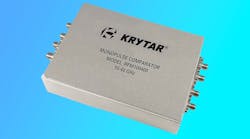Monopulse Comparators Offer Ultra-Broadband Beamforming from 0.5 to 40 GHz
The Overview
KRYTAR recently launched a new family of monopulse comparators that implement beamforming in multiple microwave bands from 0.5 to 40 GHz. These devices are beamforming networks comprised of hybrid couplers that feed phased arrays of antenna elements, controlling the direction of a beam, or beams, of radio transmission.
Who Needs It & Why?
Monopulse comparators, such as those offered by KRYTAR, are highly suited for antenna array beamforming, high-speed radar searching and tracking, multipath simulation and performance evaluation, and many other applications. With coverage from the L-band through the Ka-bands, KRYTAR’s devices perform angular beamforming and deliver excellent functionality paired with ease of use.
Under the Hood
For monopulse comparators to be effective in beamforming, there are some key properties to look for in the devices’ specifications. These include bandwidth, phase and amplitude imbalance, high isolation, low insertion loss, and VSWR. A look at the datasheet for one example of KRYTAR’s offerings, the RFM100400, shows the following:
- Bandwidth: 10 to 40 GHz
- Phase imbalance: ±26° maximum
- Amplitude imbalance: ±2.0 dB maximum
- Isolation: >17 dB minimum
- Insertion loss: <12.3 dB minimum
- VSWR: 2.2 dB maximum
- Power rating: 20 W
The new family of 10 monopulse comparators is comprised of the company’s high-performance 180° hybrid couplers. The comparators come in a compact package with coaxial connectors.

